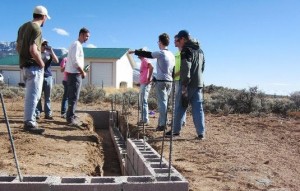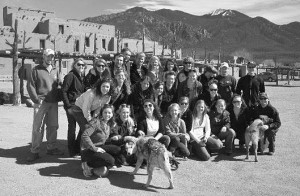Every year, the Gustavus Center for Servant Leadership (CSL) sends a group of students to various locations around the country to participate in building houses with Habitat for Humanity.
“Habitat for Humanity has a branch called Collegiate Challenge, which is basically their alternative spring break. Interested sites submit requests and we can look at all the different sites and choose,” David Newell, Assistant Director for Community-Based Service and Learning, said.
The trips usually go to the Gulf region of the U.S., with past destinations including Biloxi, Miss., New Orleans, La., and Corpus Christi, TX. This year, three groups of approximately thirty students will head to Pensacola, Fla., Laredo, Tex., and Maryville, Tenn.
“We [want to] work on establishing relationships with these places … we also want sites where we can learn something, so that we can have a significant impact on the place we go but they can also have a significant impact on us,” Newell said.

After locations are chosen, students prepare much of the logistics of the trip. Site coordinators get in touch with staff at the destination to work out the fine details, team leaders are trained and then assigned to monitor smaller groups of students before and during the trip, the Gustavus Habitat for Humanity co-presidents offer support and help plan and the spring break intern at the CSL takes care of much of the paperwork. The student participants are required to raise a set amount of money before the trip as well in order to keep costs down.
The work trips are almost always a popular option for students. This year, an hour after the applications became available, forty-five students had already signed up. Many are new participants, but quite a few are returning.
“I had a phenomenal time last year, so I wanted to do it again, but more on the planning side. It’s so fulfilling and rewarding,” Senior Ashley Neaton, site coordinator for the Pensacola trip, said.
Newell has been going on the trip for six years and has seen the impact it has, not only on the family who is gaining a house, but on the student workers.
“The beautiful thing about this trip is that the impact goes both ways. It’s less about us going and doing amazing work, it’s about the understanding of serving somewhere else but also that we’re served in the same process. We really get to understand serving a community, but the truth is we’re visitors. We get to leave. We can come back here and do work in our own local communities … I think the big impact is that we get to understand a little bit more about another person’s perspective,” Newell said.
First-time participants share Newell’s enthusiasm, despite the 300 dollar price-tag it carries.
“It’s such a worthwhile opportunity that [even though] I have to pay something [I’ll be] getting much out of this experience; a chance to help people, make friends and enjoy a week outdoors doing something I’m actually interested in,” Sophomore Comfort Dolo, who will be participating in the trip for the first time, said.
The students get the opportunity to interact with locals at a dinner that each group always participates in, usually at a local church or community center.
“It was so rewarding to hear what an impact we were making from locals,” Neaton said.

First-year Angela Gewerth is excited to experience the culture of another region as well as make an impact.
“I believe that this experience will be a total culture shock for me. I grew up in a very small town of only 900 people—diversity was definitely lacking to say the least. This experience will open my eyes to different ethnic groups and ways of living,” Gewerth said.
Students go for a wide array of reasons, but all seem to bring a good work ethic with them.
“One thing I’ve been continually proud of on every trip I’ve been on, the site coordinator has almost always said, this is the hardest-working group I’ve ever seen. That’s just who Gusties are,” Newell said.
However, even if such a ubiquity came to pass, games are still seen as a faiincanl investment, due to the unconscionable $59.99 standard price point. The most common argument given by publishers at the beginning of the 360/PS3 generation for the price increase was that next-generation games were more difficult and, critically, more expensive to develop. While it is true that game development budgets increased significantly from the PS2/Xbox generation to the 360/PS3 generation, they are still, with the exception of a very few outliers, far below the average budget of a feature film. The key difference, as I have argued previously, is the difference in audience size. $10 DVDs sell to tens of millions of consumers and make a handy profit on $100 million dollar films. If a game sold to tens of millions of consumers, it wouldn’t need to be priced at $60 to make a profit on its measly (by comparison) $20 million development budget. And if you’re wondering where we find those extra customers, all you have to do is lower your price point.